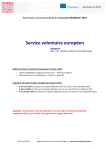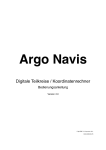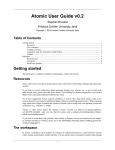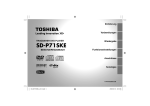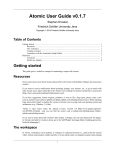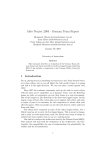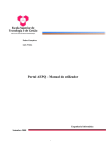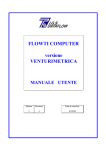Download UMAC Content Management System User Manual - Hu
Transcript
UMAC Content Management System User Manual Version 1, 22/09/2009 Table of Contents Introduction.........................................................................................................................2 Theory of operation............................................................................................................3 Site Structure...............................................................................................................3 Menus..........................................................................................................................5 Content Types..............................................................................................................6 Access Levels..............................................................................................................7 System and Software Requirements................................................................................8 Account...............................................................................................................................9 Logging In (All Levels)..................................................................................................9 Logging Out (All Levels)...............................................................................................9 Actions Log (Editor, Publisher, Administrator)..............................................................9 Change Password and User Data (Editor, Publisher, Administrator)...........................9 UMAC Calendar.................................................................................................................10 Creating and Editing Content (Editor, Publisher, Administrator).................................10 UMAC Bibliography (Preliminary)...................................................................................11 Creating and Editing Bibliography Entries (Editor, Publisher, Administrator).............11 Setting the Visibility of an Entry (Editor, Publisher, Administrator).............................12 Standard Content Pages..................................................................................................13 About Rendering of Web Content...............................................................................13 Editing Standard Content Pages (Publisher, Administrator).......................................14 The Editor...................................................................................................................15 Restrict Editing Access for Standard Content Pages (Administrator).........................17 Upload and Manage Files (Documents and Images).....................................................18 Getting Information About Uploaded Files (Publisher, Administrator)........................18 Upload a File (Publisher, Administrator).....................................................................18 Members Database...........................................................................................................20 Creating and Editing Member Entries (Administrator)................................................20 CMS Administration..........................................................................................................21 Manage Site (Administrator).......................................................................................21 Manage Vocabularies (Administrator)........................................................................23 Manage Users (Administrator)...................................................................................23 UMAC Content Management System: User Manual Page 2 Introduction The UMAC Website and Content Management System (further called UMAC CMS) enables the UMAC community to create, edit and manage website contents, structured (database) information and site structure via a web browser independent of location and operating system. Only a minimal understanding of technical basics of web publishing is needed, according to access privilege and undertaken task. The main features are 1: ‣ Complete control over site structure, content types, content, visibility based on access level, menus and submenus ‣ Standard web page content (text, images, links etc.) may be alternatively edited with a rich text What You See Is What You Get-Editor or with a HTML Source Code-Editor for advanced editing tasks ‣ The UMAC CMS completely integrates legacy content, design and structure from its predecessor, including the now fully integrated members database ‣ Database-based content modules (members database, calendar, bibliography) ‣ Upload, management and linking of files (e.g. PDF-documents) and images ‣ A tiered access level system based on privileges and tasks: - Public: Unprivileged access to published website content. Default level when visiting the website - Member: Access to internal member pages and personal information of the members database (the legacy „umacmb“ user) - Editor: All privileges of member plus creating and editing of records of the calendar and the bibliography module - Publisher: All privileges of editor plus editing of standard content pages, upload and management of files - Administrator: All privileges of publisher plus full authority to change website structure and access, editing of members database 1 As the CMS is a dynamic and configurable system, all information in this manual is subject to change. Newer and updated versions of this manual may be published. UMAC Content Management System: User Manual Page 3 Theory of operation Site Structure Like most of the sites on the net, the UMAC CMS is modelled on a hierarchical, tree-like structure. It consists of single pages or views, which are either ‣ top-level pages positioned directly „under“ one of the root-level nodes (represented by the horizontal menu) and identified by the second-level vertical menu on the left Top-level page “What is UMAC?„ belongs to root level node „About“ and is positioned at second place in the menu (left) UMAC Content Management System: User Manual Page 4 ‣ or sub-pages. These sub-pages „belong“ to a root level (top) node and a top-level page (left), but they may be only identified (and accessed) via a submenu on the page (or by a direct link) The sub-page „UMAC Board Gallery“ is positioned as sub-page of the top-level page „UMAC Board“. It is accessed via a automatically generated submenu on the page directly under the headline. As sub-pages may be positioned under other sub-pages, the site structure may spread on a number of levels, as it actually does in the „Conferences“ section. UMAC Content Management System: User Manual Page 5 Menus Individual pages of a website are usually accessed via menu links (website navigation). The first two levels (root and top) are accessed via the respective menus on top (root level) and on the left (top-level pages). Things get a bit more complicated if there are subpages: To access these pages, there may be a submenu on the page which enables access to these sub-pages. Submenu on the „Conferences“-page, enabling access to sub-pages „Past UMAC Conferences“ and „Other Projected Conferences“. A submenu usually shows on the first position the „parent“-page (here: „Conferences“), and subsequently all children (here: „Past UMAC Conferences“ and „Other Projected Conferences“) Additionally, a sub-page may theoretically be part of two distinct submenus: ‣ the submenu it is (as child) part of (like „Past UMAC Conferences“ as child of „Conferences“), and ‣ the submenu it has itself as parent, if it has other sub-pages as children (In this case „Past UMAC Conferences“ would be positioned first). The Site Management module letʻs a site administrator decide for each page if ‣ a submenu should be shown at all (provided there is one available), and ‣ which submenu should be shown, provided it is a page which is as child part of a submenu and if the page itself has children and therefore a submenu UMAC Content Management System: User Manual Page 6 Content Types For each page the site administrator may configure which content type it represents. The most prevalent type is „Standard Content Page“, there are additionally the types for the different modules (calendar, members, bibliography). Above: Standard Content Page (for logged-in Publishers and Administrators easily identified by the „Edit Page“-Link on the top-right) Below: Calendar Module with module-specific options UMAC Content Management System: User Manual Page 7 Access Levels Based on the access level (acquired by logging into the system) a page may show different options. If a user tries to access a page for which a certain access level is required, the system automatically requests username and password. For the public, the UMAC Calendar shows a different interface than for logged-in users. Note the different status indication on the top right: „login“ for unauthorized (public) guest access (above), and „account [username]“ (below, in this case, the „site administrator“), who has edit privilege for calendar entries. UMAC Content Management System: User Manual Page 8 System and Software Requirements Apart from being online and using a standard web browser, there are no additional system or software requirements. Your web browser should be configured to ‣ allow execution of Javascript ‣ allow the storing of a „session cookie“ Both options are usually enabled in browser default configurations. The UMAC CMS has been developed for being compatible with current and future web browsers. As it is heavily relying on Javascript (an in-browser script execution environment), it is recommended to use the latest available versions of browsers, which give good performance in executing Javascript and which comply with web community standards. Recommended browsers (all of which can be downloaded and used at no costs) are2: ‣ Mozilla Firefox, version 3 and above (Windows, Linux, Mac OS X) http://www.mozilla.com/firefox/ ‣ Apple Safari, version 4 and above (Windows, Mac OS X) http://www.apple.com/safari/ ‣ Opera, version 9, 10 and above (Windows, Linux, Mac OS X) http://www.opera.com/ ‣ Google Chrome, version 3 and above (Windows, Linux and Mac versions announced) http://www.google.com/chrome/ Also supported (while having minor performance issues) are: ‣ Microsoft Internet Explorer, version 8 ‣ Microsoft Internet Explorer, version 7 3 Not recommended and not supported are: ‣ Microsoft Internet Explorer, version 6 and below (visual glitches, security concerns, non-standard rendering of web content) ‣ Mozilla Firefox, version 2 and below (security concerns) ‣ Apple Safari, version 3 and below (not tested, possible visual glitches and possible security concerns) ‣ Opera, version 8 and below (not tested) 2 If you are experiencing a very slow page performance, please check if you have anti-virus or anti-malware software installed which intercepts Javascript execution in browsers. You may safely, if possible, deactivate this feature for the UMAC CMS domain, as there are no security risks involved in using the system. 3 There may be some visual glitches, but overall compatibility should be available. UMAC Content Management System: User Manual Page 9 Account Logging In (All Levels) To login, simply click on „login“ on the top-right. After successfully providing username and password, you are directed to the account page (or you may find it via Internal > Account), which indicates your account information including access level and actions which this level entitles to. Logging Out (All Levels) You may logout via Internal > Logout. To protect the site from unauthorised or malicious access, please always logout if your work is finished. Actions Log (Editor, Publisher, Administrator) The Actions Log (Internal > Actions Log) shows recent changes, indicating time, user, module, type of action and the actionʻs object (calendar entry, page etc.). All dates and times are UTC/Greenwich Mean Time. Note: Not all actions are logged. E.g. User Management and Vocabulary Management actions are not logged. Change Password and User Data (Editor, Publisher, Administrator) From the Account page (Internal > Account), you may change your user information: ‣ Real name: The name youʻd like to be identified by ‣ Password: Change your password. Please use a password which canʻt be easily guessed and which canʻt be found in a dictionary Note: If you have forgotten your password, it canʻt be retrieved, as all passwords are encrypted by one-way-encryption before being stored. In this case, request a new password from an administrator (email address is indicated on the login page) and change it immediately after your first login to ensure the privacy of your access information. UMAC Content Management System: User Manual Page 10 UMAC Calendar The UMAC Calendar shows to the public current and future events, past events are automatically hidden. Internally, all events may be accessed via the „Show Month“selection. Creating and Editing Content (Editor, Publisher, Administrator) A calendar entry consists of the following fields: ‣ Title: Descriptive event title, shown in bold on the calendar page ‣ Day: Day or days of the event. A special calendar widget helps to select the day and formats the entry appropriately (the format is: yyyy-mm-dd) ‣ Time: Start and finish time of a single day event (optionally, will not be shown if event last longer than a day) ‣ Description: Free text field, usually used to indicate location and/or event organiser ‣ Link: URL of link to further information about the event. Use full URLs (with „http://“ at the beginning, you may copy them from your browserʻs address bar). If no text for the link is given, „Further Information“ is used ‣ Visibility: 2 Options: „Public“ for public access, „Internal“ for access only to logged-in users (Member, Editor, Publisher, Administrator) UMAC Content Management System: User Manual Page 11 UMAC Bibliography (Preliminary) The UMAC Bibliography is a newly developed module, its contents, structure and classification system are subject to change & discussion. Note: As of the publication date of this manual, the bibliography may be only accessed by Editors, Publishers and Administrators. This may change as soon a consensus is reached within the community. Creating and Editing Bibliography Entries (Editor, Publisher, Administrator) A bibliographic entry consists of the usual and expected fields (the precise structure is currently subject to discussion and change). Dependent on publication type there are different ways to set or select the fieldsʻ contents. ‣ Publication Type: Obligatory. It is important to select the correct publication type. If, after editing, the display of the entry doesnʻt meet your expectations, it may well be because of wrongly chosen Publication Type. Publication Type Description Article Article in a journal or periodical Book A monograph with an optional single author or group of authors. May also be used for other types like databases, CD-ROMs etc. Edition An edition with an optional single editor or group of editors, which are not identical with the authors of individual chapters or essays Inbook An individual chapter or essay within an edition, with an optional single author or group of authors Periodical A periodical or journal, with an optional editor or group of editors UMAC Content Management System: User Manual Page 12 ‣ Title: Obligatory. The title of respectively the article, book, essay/chapter, edition or journal/periodical ‣ Author(s), Editor(s): The contents of these fields depend on the publication type and are all optional. If there are more than one author/editor, separate them with a semicolon. Surname first, then first name, separated by a comma. Example: Frost, Robert; Miller, Henry James Publication Type Author(s) Editors(s) Article ... of article ... of journal/periodical (?) Book ... of book empty Edition empty ... of edition Inbook ... of chapter/essay ... of edition Periodical empty ... of journal/periodical ‣ In: Only used ... ... in case of Article: for title of journal/periodical ... in case of Inbook (chapter/essay): for title of edition ‣ Further bibliographic fields (dependent on publication type) ‣ Link(s): One or several links. Use full URL (with „http://“, you may copy from your browser address bar) and set a descriptive title (like „Full Text“, or „Further Information“). Please consider, that some websites (especially with electronic versions of publications) require special privileges and are not accessible to everybody ‣ Category, Language: Multiple-select fields. Select one or more terms from the list on the right (by clicking on them). If you would like to remove a term, deselect its checkbox Setting the Visibility of an Entry (Editor, Publisher, Administrator) On the single display of a bibliographic entry, you may set its visibility to either ‣ Public (Visible to everyone), or ‣ Internal (Visibile only to logged in users) Note: As long as the bibliography is accessible only to users with the access level of Editor and above, this setting has no immediate effect, as the visibility doesnʻt override the overall access setting. UMAC Content Management System: User Manual Page 13 Standard Content Pages Most pages of the UMAC website are standard content pages – pages where freely structured and styled web content is rendered, with headings, paragraphs, lists, images, hyperlinks etc.. As most users arenʻt specialists for web content creation and editing, the UMAC CMS provides a rich text or WYSIWYG 4-editor which assists in basic editing tasks. About Rendering of Web Content The pages you view when surfing the web are renderings provided by the web browser locally and „on-the-fly“ (hence the more or less major differences when using different browsers on different operating systems). What a browser actually loads „from“ the internet is text content which contains along the textual data instructions how this text content should be rendered, if there are additionally images to be loaded, where they are to be placed, and various further instructions. These instructions are encoded in a specific so called markup language called HTML (HyperText Markup Language). Consider the following rendered web content: Let‘s jump over the fence! The actual HTML source text the browser loaded looks like that: Let‘s <b>jump</b> over the fence! The HTML instructions <b> and </b> (also called „tags“) create an HTML Element, which instructs the web browser to draw the „jump“ bold (b = bold). Blocks There are many tags and tag types. The most important are block-building tags which structure text content semantically and visually. Consider following excerpt from the UMAC website, as rendered by the web browser: 4 What You See Is What You Get - an acronym for graphical oriented tools (like word processing software) which more or less show while editing the content as it is being rendered in print or, in this case, in the web browser. UMAC Content Management System: User Manual Page 14 The actual HTML source text (the colouring is for orientation only): The HTML instructions (tags) h1 (heading level 1), p (paragraph) and ul/li (unordered list, list item) structure the content and render it readable and understandable. When editing content pages of the UMAC CMS, you may choose between an editor, which assists in creating web content (it translates to a certain point your input into valid HTML) and an source editor, which allows the editing of HTML source text directly. Editing Standard Content Pages (Publisher, Administrator) By clicking on „Edit Page“ you may edit a pageʻs content. Available fields are: ‣ Headline: The headline of the page. Contains pure text. ‣ Text Body: The page content, containing rich (HTML) web content (styled and structured text, images, links). The editor is explained in the following section. UMAC Content Management System: User Manual Page 15 The Editor be re d Bu Li lle st t Bl ed L oc kq ist uo In te se r Re t Lin m o k In ve se Li n rt Im k Sh ow age Bl oc Sh ks ow an d Ed it Re So m ur ov ce eS ty lin g m Nu kT yp oc Bl Ita Bo ld lic es The editor for Text Body content creation and editing is both a rich text editor and a source text editor. Its size can be adjusted by using the handle in the bottom right corner. On top is a toolbar with various tools and options for content editing. Basic text input First you should type the text content into the editor window without any styling. Use the [Enter] key for structuring the text (it automatically creates for each [Enter] a new paragraph). If you want a line feed without creating a new paragraph, press [Shift]+[Enter]. Structuring the page With the block types Normal (paragraph), Heading 2, 3 and 4, Numbered List, Bulleted List and Blockquote you may format and structure your text. Place the curser into a text block and click on or select one of the options available. If you want to remove e.g. a list, place the curser into the list block (list item) and select the option again – the formatting will be removed. You may click on Show Blocks to display the text structure. Styling You may render inline text Bold and Italic. Select the content and click on one of the options. For removal, click on the option again or choose Remove Styling. Inserting Links To create a link you must have the full URL5 (address) of the target webpage (with „http://“ at the beginning), you may copy it from a browser address bar on the top. Select first the text content youʻd like to activate as link and click then on Insert Link. 5 URL = Uniform Resource Locator UMAC Content Management System: User Manual Page 16 A modal window opens with various tabs of which only the first is necessary: paste the address (URL) into the field „URL“ and click on „OK“. To edit a link, place the cursor inside it and click on Insert Link again. To remove a link, select the full link text and click on Remove Link. „Internal“ Links There is a special procedure in case of so called internal links which are links which point to target webpages within the UMAC website itself: ‣ Insert internal link: the same procedure as described above. Paste the full address/ URL (with „http://“ at the beginning) ‣ Edit internal link: to ensure correct paths for the future, the system processes and changes some of the internal links on saving the page. If you edit an internal link, you must either - paste the full address/URL into „URL“ again, or - make sure that for „Protocol“ the option „<other>“ is selected (you may detect an internal link if there is no domain name like publicus.culture.huberlin.de in the „URL“-box) Inserting Images Place the curser at the position youʻd like the image to be put at and click on Insert Image: ‣ Paste the full image address/URL (with „http://“) into „URL“. After changing to another field, the „Preview“ should show the image. ‣ Fill in a descriptive image title into „Alternative Text“ ‣ All other options are optional for advanced image configuration and editing Note: An image canʻt be edited. It must be removed and inserted again for changes. Best Practises While the Editor does its best to produce correct and valid web page markup, it is not always successful, especially with (often complex) legacy HTML source text, when there is a lot of editing and re-editing going on or invalid or complex inputs into the source editor. It is therefore recommended to ‣ respect the sequence: insert text - proof read - structure (blocks) - styling - special tasks like links and images UMAC Content Management System: User Manual Page 17 ‣ rather than edit an element remove it and insert it again Restrict Editing Access for Standard Content Pages (Administrator) As Administrator it is possible the restrict Edit Access for a single content page to Administrators, mainly to protect complex HTML Source from accidental editing. This can be set in the Edit Page window for Administrators. Publishers will then simply not be offered the Edit Page link. UMAC Content Management System: User Manual Page 18 Upload and Manage Files (Documents and Images) Publishers and Administrators may upload documents and then refer to them (by link) on public and internal pages for public or internal sharing. Getting Information About Uploaded Files (Publisher, Administrator) The file management tool can be found at Internal > Files/Upload. There are two directories for uploaded files: „Documents“ (at /pdf) and „Images“ (at /img). Click on one of the links in the menu on top to see a directoryʻs contents. By clicking on Info for a file, youʻll see ‣ the full path (URL) of the file in a text box, prepared to be copied and pasted for linking on content web pages ‣ a link to see or download the file ‣ information about file size and last modification date and time (this is usually the serverʻs local upload time) ‣ a link to delete the file. If you are going to delete a file, please note: this action can't be undone and references to the file on this and other websites won't be removed and will generate an error after deleting Upload a File (Publisher, Administrator) Before uploading a file, please ensure: ‣ it is a document or image in a common format which can be opened by the intended audience, like PDF (Adobeʻs Portable Document File). In case of images, compatible formats for web display are JPG, PNG and GIF (you may discern the format of files by looking at their extension, like report.pdf or group.jpg) ‣ the file is not larger than 7 Megabytes (7MB) (larger files wonʻt upload) ‣ the file name does not contain any spaces or characters apart from characters of the English alphabet, numbers, hyphens (-) or underscores (_) UMAC Content Management System: User Manual Click on Upload a File (at Internal > Files/Upload): ‣ select the file from your computer ‣ choose document type (Document/Image) ‣ decide what to do in case there is already a file with the same name (this way you may update a already available document) ‣ click on Upload. The file is now being uploaded. Please be patient and wait for the confirmation page. Depending on file size and connection speed, the upload may take a while. Page 19 UMAC Content Management System: User Manual Page 20 Members Database The members database contains institutions, web-addresses, names, addresses, email and other contact data of UMACʻs members. What is displayed depends on who is viewing: Public viewers may view country and institution names, while logged in members (Member and above) may access full members information. Creating and Editing Member Entries (Administrator) Updating and maintaining the members database is in the hands of one of the UMAC CMS administrators. The fields of an membership entry are a result of the requirement of UMAC membership registration and administration. UMAC Content Management System: User Manual Page 21 CMS Administration Manage Site (Administrator) The site management module allows complete control over site structure, menus, paths, content types and access. Please read the chapters „Introduction“ and „Theory of Operation“ for an understanding of the underlying architectural and design principles of CMS structure and procedures. Youʻll find the module via Internal > Manage Site. Select a Root Menu for an overview of this menuʻs structure. The numbered items represent the top-level pages and therefore the top-level menu on the left sidebar. Further indented items are sub-pages. In the second line youʻll find information about ‣ the path-component of that page (which is used to generate the URL of that page), clickable ‣ the access level which is needed to access the page ‣ the type of the page (Standard Content Page or one of the other module types) UMAC Content Management System: User Manual Page 22 Click on Edit Properties to change a pageʻs configuration: ‣ Page Name in Menus: Name of page in menus ‣ URL Path: The path component to build the pageʻs URL. Use only alphanumeric characters (lowercase) and hyphens (0-9, a-z, -). A pageʻs full URL consists of the websiteʻs address plus the path component: UMAC website URL: http://umac.icom.museum Path component: /index Resulting page URL: http://umac.icom.museum/index ‣ Page Position: The position of the page. If it is a top-level page, parent is the Root Menu Node ‣ Submenu Preferences: If there is a submenu (the page has a parent page or is parent page of sub-pages), decide if the submenu should be shown. If the page is both - as child part of a submenu and as parent has a submenu - you may choose which of theses submenus to show on the page ‣ Page Access: Which level is necessary to see the page in navigation menus and to access the page. If other than Public is selected, users must login to the system with the necessary user level before having access ‣ Page Type: Select, if a Standard Content Page is to be displayed, or one of the other page types Ordering and Reordering Menus All pages on the same level (all pages which have the same parent) may be reordered for their display in menus. Use Move up to move a page up one item within the list of its siblings. There is no „Move down“-command – if youʻd like to move an item down the list, move the others up. UMAC Content Management System: User Manual Page 23 Manage Vocabularies (Administrator) Access this module at Internal > Manage Vocabularies and use it to edit the vocabularies used (at this time) to index the UMAC Bibliography (Categories and Languages). You may add a term, change a term or delete a term. If you change or delete a term from a vocabulary, various background processes are triggered to keep the database information consistent. If a term is used very often within the database, these background processes may take a while. Therefore, after clicking on Update or Delete, in some cases – depending on affected database records and server performance – it may take a while to complete the action. Please be patient to ensure a consistent database structure. Manage Users (Administrator) Use this module at Internal > Manage Users to set and change CMS user data. ‣ Username: Used as identification at login. Please use only alphanumeric characters, preferably lowercase UMAC Content Management System: User Manual Page 24 ‣ Real name: The real name of the User, displayed on pages and in the Actions Log ‣ Access level ‣ New Password: Set a new password (repeat it to secure proper input). The password should be one which can‘t be easily guessed and which can‘t be found in a dictionary Please note: ‣ An administrator canʻt change his/her own Username and Access Level ‣ Passwords are stored encrypted and canʻt be decrypted. If a user has forgotten his/her password, set a new one and request the user to change it him-/herself the next time he or she logs in
























